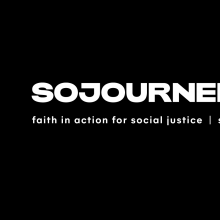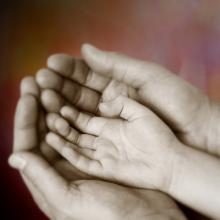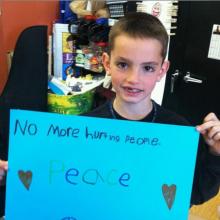Parenting
Before I knew God, I knew Joseph.
If you grew up in the 80s, like I did, there’s a decent chance that your earliest knowledge of Joseph’s story came through a local high school or community theater production of Joseph and the Amazing Technicolor Dreamcoat. That musical (by Broadway legends Andrew Lloyd Webber and Tim Rice) playfully (and rather faithfully) tells the story of a young boy, the favorite son of the patriarch Jacob, who sets in motion both a family and a geo-political drama by flaunting his fashionable coat. As a youngest child, I loved the story—I fancied myself as the favorite son, destined for greatness, who would one day be like Jacob, irresistible to the ladies. There is a time in life when each of us is made up of ego needs and delusions of grandeur.
We all know heartache. It’s one of our shared experiences. We love someone, and our hearts ache with them and for them at times. Other times, we feel heartache because of them. It’s all part of it.
To have a heart that loves is to have a heart that aches.
One of the great stories about aching hearts involves a prodigal son. It’s a story about love and heartache — which means it’s a story about all of our lives.
When the son returns home from spending his father’s money so recklessly and completely, he gets a totally unexpected response. Instead of being shunned or judged, he’s welcomed back with a tearful hug and a rowdy party.
A hug and a party? How could this be?
It’s what happens when someone loves you so much that their heart aches.
MY 5-YEAR-OLD daughter, Zoe, is in preschool. This means, as most parents of school-age children know, that there is a birthday party to attend approximately every other weekend of the year.
On the way to one of these myriad celebrations, we stopped by the church in downtown Portland, Ore., where my wife, Amy, is the senior pastor. She had a daylong meeting, and we needed to switch cars, as hers was the one with the gift in it.
As we came down the front steps of the church and onto the South Park Blocks, a local city park, we saw at least half a dozen emergency vehicles parked in a haphazard formation along the street and on the sidewalk in front of a small public restroom. Several officers were standing together, making calls on their radios and discussing the situation at hand. At their feet was what appeared to be a lifeless body, lying on the pavement underneath a blue tarp.
“Daddy,” Zoe said, “what are those police mans doing in the park?”
“I’m not sure, honey,” I said, “but it looks like somebody needed their help.”
“Is somebody in trouble?”
“Something like that,” I sighed. “Make sure you don’t drag that gift bag on the ground. We don’t want to mess up your friend’s present before we get to the party.”
My first thought was, God, please don’t let it be Michael. Michael is a man about my age who lives outside and wrestles daily with an addiction to alcohol, among several other things. We have helped him get sober, only to see him relapse. We helped him get into supportive housing, only to watch him get into a fight and get thrown back out onto the street.
Every mother and father know the struggles, frustrations, unrealistic expectations, horrific fears, and exhaustive drama associated with raising children, but let me just say this: Christianity adds an entirely new dimension to the chaos that is parenting.
Besides an assortment of play dates, sports activities, school classes, music events, and other social obligations, Christianity requires the additional burden of attending an endless array of church activities.
Mission trips, youth groups, service projects, summer camps, volunteer activities, Sunday school classes, Bible studies, evangelism outings, and church services require tons of time — it’s a huge commitment.
Christian culture goes out of its way to accommodate parents and their children, and while this is a good thing, it also adds social expectations that can often feel burdensome and frenetic — leading to burnout.
What does it take to educate and parent African-American children, all while maintaining family values?
NEARLY 50 YEARS ago, the U.S. Department of Labor issued one of the most controversial and influential reports of our time, “The Negro Family: The Case for National Action,” aka “The Moynihan Report,” named after its author Daniel Patrick Moynihan. The March 1965 report offered our nation’s first comprehensive look at the roots of poverty in the African-American community 100 years after the Civil War. The picture wasn’t pretty.
Pointing to black poverty’s roots, Moynihan started with the hell that was the U.S. slave system: “American slavery was profoundly different from, and in its lasting effects on individuals and their children, indescribably worse than, any recorded servitude, ancient or modern.” Going on to quote Nathan Glazer, Moynihan illuminated the absolute powerlessness and dehumanization of enslaved black people under antebellum law and within the social structures of slavery.
Moynihan went on to examine the impact of the Reconstruction period, urbanization, unemployment, and inequitable wages on African Americans’ economic station in U.S. society. He concluded that the single greatest result of these forces was black families’ demise. And the single greatest result of this demise was entrenched poverty, according to Moynihan.
A 2013 Urban Institute report, “The Moynihan Report Revisited,” reflected that in the early 1960s Moynihan was alarmed that 20 percent of black children lived in single parent households with their mothers (not their fathers), but by 2010, 20 percent of white families lived in such households while 53 percent of black children were being raised by their mothers. According to the Urban Institute, fatherlessness in the U.S. has gotten worse, and it is no respecter of race.
I became a mom for the first time in November. Insert here all of the cliché observances about life-changing experiences and never knowing love before and having a better understanding of God and whatnot. Of course, they’re all true, but so are most clichés.
There are also things no one tells you, instead using above clichés to paper over the less desirable realities of parenthood. No one told me about that feeling — the feeling that the word “overwhelming” doesn’t even begin to describe. No one told me that feeling that makes you weep inconsolably and go off the rails at the thought of leaving the house is actually what it means to love your child. That size of love is truly overwhelming.
While I was pregnant, I tried really hard to avoid all of the parenting books — how to raise well-behaved children, the countless “methods” for getting your child to sleep, how to master breastfeeding (“the most natural thing in the world!” ugh, wrong) — in favor of being a “go-with-the-flow” type parent. In fact, the only book I really read and still lives in a stack by my nightstand is The Sh!t No One Tells You: A Guide to Surviving Your Baby’s First Year.
And being the future mother of a girl, I had grand ideas about “protecting” her from human-made gender norms. I ordered the “Forget Princess; Call Me President” onesie. I shunned head-to-toe pink (for about a week). I created a collage wall in her nursery of black-and-white photos of all of the badass women in her family she has to look up to.
And then this week I caught myself doing something that has the potential to harm my daughter more than being drenched in pink and purple for the next 18 years ever could.
Editor's Note: The following is an excerpt from Joy Carroll Wallis' chapter of the book Faith Forward: A Dialogue on Children, Youth and a New Kind of Christianity.
“Offering your child to God is a way of offering yourself to God again, and it felt that way to me. For the religious and not, there is a powerful spirituality in the birth of a child. Already, we’re learning a little about the unconditional love of God for us in the way we feel about our own child. Through one of the most universal human experiences, parent after parent is taught the lessons of love and life. And all is grace.” – Jim Wallis, following the birth of his son, Luke
Jim and I grew up in Christian families, which brought with it both advantages and disadvantages. My father was a clergyman in the Church of England in the inner city of South London. Jim’s parents were the founders and leaders of a Plymouth Brethren congregation in Detroit. We both rebelled and returned and our stories are well documented in the books we have written.
One of the best gifts that we experienced as the children of Christian leaders was that of an open home. Exposure to family, and friends from many different cultures and walks of life helped shape us. But, more importantly, it allowed us to grow up participating in the ministry of hospitality – and that has stuck. The Wallis home is known to be an “open house.” Our guest room belongs to many people: from a professor teaching a course in town, to a church leader participating in a fellowship program or conference; from a patient recovering from major surgery or illness, to a summer intern visiting from a far-flung part of the world. To add to this, the basement and boys’ rooms are often filled with teenagers or most of a baseball team, and our dining table is full to capacity on a regular basis.
One day when just the members of our family were sitting down to eat dinner, Jim asked who would like to say grace. Jack, who was about four at the time, looked around and said, “But we don’t have enough people!”
It’s taken me a few years, but I’ve decided to relax about him. I refuse to beat myself up over his presence anymore. He’s okay. I mean, don’t get me wrong — he’s annoying and I have concerns. And I know that many of my fellow parents will disagree, and that’s okay. This makes me cringe, but that little Elf on the Shelf can stay.
After some debate, my wife bought the Elf on the Shelf in 2010. If you aren’t familiar with the Elf on the Shelf myth, it goes something like this: Apparently Santa is incapable of knowing if children have been bad or good on his own, so Dec. 1 to Dec. 24 that Jolly Old Elf sends his little elves to houses to spy on boys and girls. Their job is to check to see if children are being naughty or nice. So, each morning before anyone is awake, our Elf flies in from the North Pole and hides in a different spot in our house. When our children wake up — noticeably earlier in December than any other month — they look for him. Yup, it’s hide-and-seek every morning with the Elf. Then, the National Security Agency Elf spies on our children throughout the day. When our children fall asleep at night, the Elf flies back to the North Pole to provide Santa with a report on how our children have behaved. Then the Elf promptly flies back to our house, hides in a new place, and the morning hide and seek ritual begins again.
Truth be told, my children love it. They. Love. It. They can’t wait to wake up in the morning and search for that little Elf.
Before we had kids, we loved to travel, had worldview stretching experiences, and were all together creative in how we lived the lives we had been given. For us, having the right kind of experiences meant far more than have the right kind of house, car or, other possession that could be associated with “success.” As we reflect on our development individually and as a couple in the context of marriage, it is clear that these experiences (and resulting relationships) have shaped us more significantly than any classroom or lecture series. It has been the classroom of real life relationships that have formed us into global citizens who follow a Jesus with a global reign.
And then we had kids …
After traveling the country this spring — while keeping an eye on Washington, D.C. — I am more convinced than ever that our personal decisions, choices, and commitments will change the world more than our politics. The message in the Epilogue to On God’s Side says this as well as I could do again. It’s short and very practical. Here it is:
The common good and the quality of our life together will finally be determined by the personal decisions we all make. The “commons” — those places where we come together as neighbors and citizens to share public space — will never be better than the quality of human life, or the human flourishing, in our own lives and households.
Here are ten personal decisions you can make to help foster the common good.
WE OWE A lot to Anne-Marie Slaughter. Last summer, the Princeton University professor’s Atlantic article “Why Women Still Can’t Have It All” kicked off an overdue, protracted national-scale debate on the difficulty of juggling the demands of professional success and committed parenting, the likes of which we haven’t had in a while. Shortly after Slaughter’s polemic hit newsstands, Marissa Mayer, just 37, was named CEO of Yahoo!, becoming the youngest CEO of a Fortune 500 company at the time and stirring controversy when she revealed that she was seven months pregnant. (Months later, she banned telecommuting companywide and was sharply criticized by some as being “anti-parent.”)
Then, Facebook COO Sheryl Sandberg got in on the action, publishing in March the ambitiously titled Lean In: Women, Work, and the Will to Lead. In the following months, it sat at the top of bestseller lists, with staggering sales triggering multiple printings. Sandberg, one of the wealthiest women in the world, donates all related profits to her newly established nonprofit, also called Lean In, encouraging women to form consciousness-raising Lean In Circles, in which they’ll discuss money and maternity.
Suddenly, there was a lot of estrogen in the air. A year into this cultural conversation, we’re still trying to make sense of what it all means.
First, a caveat. I don’t know anyone, woman or man, naïve enough to believe that any of us can have whatever “it all” entails. When Slaughter’s indignant article set off a firestorm about the impossibility of work-life balance, I was happy (as I always am) to witness a (mostly) thoughtful discussion unfold. But I was and still am miffed that anyone thinks women were sold a false bill of goods. Who was that mightily influential yet terribly mysterious person who promised us everything we ever wanted? How did we let him (it must have been a “him”) get away with spreading such a vicious lie, and why do we allow it to persist?
Look for a billboard on the right and a sign on your left. There’s a dirt road. Turn there.
In this part of the world, most of the streets have no names. So the directions we were given to find the new compound where my son’s Malawian relatives relocated a few months earlier were pretty specific given the circumstances.
We had hoped to be able to visit with Vasco’s 16-year-old half-brother, Juma, his Aunt Esme, and a handful of cousins and other relations for a couple of hours. By the time we found the family’s new compound, we had less than an hour before we had to get back on the road, meet the rest of our traveling companions, and head north before the sun fell.
I was heartbroken. But when we pulled up in our van, Vasco’s relatives were so happy to see us (and vice versa) that even the woefully short visit felt richly blessed. It had been three years since we’d seen each other. The last time was in May 2010 when Vasco, my husband, and I traveled from California to Blantyre for our adoption hearing. We spent a month in Blantyre and were able to get to know Vasco’s extended family (or, sadly, what remains of it) and begin piecing together our son’s complicated biography.
Since our last visit, Vasco, now 13, has grown about a foot and then some. He’s also traded his close-cropped “Obama cut” for Bob Marley-esque locks. Vasco wasn’t the only one who’d changed – visibly and otherwise.
Malawi is one of the poorest countries on the planet, with more than 9 million people living on about $1.25 a day. HIV/AIDS, which we believe claimed the lives of Vasco’s birth parents before he would have entered kindergarten, remains a critical health issue. Among 15- to 49-year-olds, the HIV/AIDS rate hovers above 10 percent despite widespread efforts to combat the fully preventable disease.
Malaria, tuberculosis, and diarrhea-related fatalities remain high in Malawi. So does unemployment, particularly among younger workers in urban areas such as Blantyre, where it is approximately 70 percent.
Over the last several weeks, I’ve been trying to figure out exactly why I feel so bothered by Sheryl Sandberg’s book, Lean In.
I suggested to my husband that maybe I’m being defensive since I am an educated woman in a professional field who has very clearly chosen to “lean out” to spend more time at home.
Or maybe it’s because I disagree with putting any degree of blame for inequality in the workforce on women.
Or maybe it’s because I don’t like the idea of human capital.
None of those reasons, however, seem to explain why the book and the phrase “lean in” have become such an obsession for me. I certainly consider myself a huge proponent of equality and women’s rights. I have marched, protested, researched, worked toward, and fought for true equality for women all of my adult life.
So my discomfort with Sandberg’s book isn’t because I’m anti-woman or anti-feminist. It isn’t because I disagree with her and want all moms to stay home and bake cookies and volunteer for PTA. It isn’t even because I feel the need to defend my choice to be a 99-percent stay-at-home mom. Instead, it’s because, as a Christian, I believe that the whole idea of “leaning in” does not take into account the principle of putting others before self. (Phil. 2:3-8). This principle applies equally to both women and men.
(Caveat: neither women nor men should be trapped into subservience by children and/or spouse. I am talking about putting the real, rational, and loving needs presented by being part of a family before one’s individual needs.)
I woke up this morning, like everyone else, to the news of a shootout with one suspect in the Boston Marathon bombing and the ongoing manhunt for a second brother. Like many others, I’ve heard lots of misinformation over the past few days about whether officials did or didn’t have a suspect, whether they did or didn’t have them in custody, and so on.
“I heard someone dropped a bomb on Boston,” said Mattias, my 9-year-old son, over breakfast while I scrolled through the breaking news reports.
“Not exactly,” I said. “It was two guys. Two brothers who came from [another country] to go to college at MIT.” They put homemade bombs in and around trashcans by the finish line of the marathon.”
“Why?” he asked.
“I really don’t know.”
“Maybe they were angry about something, and they didn’t know how to talk about their feelings.”
“Maybe so,” I nodded.
“Did they hurt people?”
First comes baby, then comes marriage? That is the new norm for many middle-class young Americans — and they and their children are paying a price, says a new report.
With 48 percent of first births now outside of marriage, “today’s unmarried twentysomething moms are the new teen mothers,” says the report, released today by the National Marriage Project, the Relate Institute and the National Campaign to Prevent Teen and Unplanned Pregnancy.
The report says reviving cultural support for earlier marriage may be part of the solution, but some experts question that approach.
The tragedy of the Steubenville rape case has provided a moral challenge to our nation. We are caught up in a highly emotional cycle of blame as we debate who the real victim is in this case. I find myself asking two questions: Why is our nation obsessed with the story and what does this story mean for us as individuals and as a culture?
My Family
I’ve always wanted a daughter. The problem is that adult Ericksen dudes tend to produce baby Ericksen dudes. My dad has 4 siblings — all brothers. I have mostly male cousins. So, when my wife and I started having children … yep … two dudes.
My Church Family
I’ve been a youth pastor for about six years, and for a long time I thought the closest I’d ever get to having a daughter was to pseudo-adopt the girls in my youth group. Actually, they first pseudo-adopted me by claiming me as their “Father” on Facebook. (Hey, it’s on Facebook, so my pseudo-fatherhood status is legit.) As something of father figure for these teenage girls, each youth group session I discussed with young women and men how the Christian faith is leading us into patterns of love and non-violence. Frequently after our sessions, one of my pseudo-daughters will tell me she’s dating a boy. So, of course, after teaching them about non-violence, I say to each of them with a straight face:
If he ever touches you, I will personally kick his ass.
It was a proud moment in the Ericksen household. The five of us sat down for lunch and my six-year-old boy said, Let’s pray.
This is every pastor’s dream. Usually I have to coerce people into prayer. Now my boy is offering to pray. With great pride and a smile on my face I said, Yes, my Son. Will you lead us in prayer?
He took a pensive moment and agreed. We bowed our heads, closed our eyes, and then … this happened,Hi God! I want something really awesome for Christmas next year! Please get me something really great! Okay. That’s all. Amen.
Both of my boys began to laugh. My proud moment was gone and replaced by a bitter sense of disappointment. I instinctively thought to myself, “Christmas! It’s February, Dude. I hope you have a lot of patience, cause you’re not getting anything remotely close to ‘awesome’ for at least another 10 months! That’ll teach you to laugh at prayer. And, by the way, you shoulda’ prayed for freakin’ world peace!!!”














